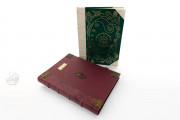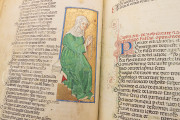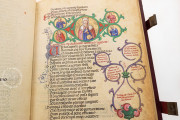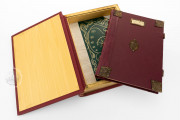The polemical astrologer Francesco Stabili, commonly known as Cecco d'Ascoli, wrote his Italian vernacular poetic encyclopedia called Acerba between 1324 and 1327. He sought to unify the concepts of astrological fate and human free will in this work that divides the 4,867 lines into five books grouped by subject. This copy was made in northern Italy in the second half of the fourteenth century and is illustrated in the Gothic style with ninety individual pictures and diagrams. Over one hundred enlarged initials with elaborate pen flourishes decorate the Gothic textualis rotunda script.
That this manuscript survives at all is a testament to the impact this text had on medieval science. Cecco was burned at the stake in Florence for heresy under the Inquisition and to even own a copy of his work meant excommunication. Despite this, thirty-one medieval manuscript copies of the work survive demonstrating its popularity. This is likely due to the use of Italian rather than Latin, which makes the text more accessible as the common use of Latin declined rapidly. This beautifully illustrated copy is a treasure of the Italian trecento, marrying together medieval science, religion, and vernacular literature.
The Fates in the Stars versus Free Will
Cecco presents in five books the components of the world of interest to natural philosophers, from astrology to certain animals and plants to stones and minerals to alchemy and ethics. Reflecting medieval thought, the magical (demons, astrology, and transmutative alchemy) is as much a part of the world as the natural, and both work to influence the minds and actions of men.
His difficulty was maintaining human free will under the influence of astrological power, but at the core of his work sought to unify the two with cohesive logical cause and effect rather than through the whims of fortune or fate. Presented as poetry, this volume is beautifully illuminated on most pages with diagrams and illustrations.
The Anti-Dante
The first and second books stand as a strong commentary against Dante Alighieri's model of the world made popular in his Divine Comedy. The two were contemporaries and corresponded. Although Cecco d'Ascoli disagrees with the project and basis of the Divine Comedy, he acknowledged Dante as a fellow intellect and worthy of debate.
Although they disagreed about the nature of humanity's place in the world, they both played a powerful role in the elevation of vernacular philosophy and literature, and influenced the arts, science, and culture of the later Italian Renaissance.
Cecco d'Ascoli: Astrologer, Poet, and Heretic
Controversy followed Cecco d'Ascoli throughout his adult life. A polemical figure, he taught astrology at the University of Bologna and was brought up on charges of heresy twice; the second resulted in his being burned to death in 1327 at the age of 70.
He was still composing L'Acerba at the time of his death, leaving the work unfinished. Although the original patron of this copy is unknown, opposite the first folio is a heraldic device of silver and gold quartered, the identity of which is unknown.
The manuscript was later owned by Giovanni Mazzuoli de Strada, donated by him to the Accademia degli Umidi in the fifteenth century. When this foundation merged with Magliabechiana collection, the book entered the new Laurenziana Library in the eighteenth century.
The current binding is a circa 1900 restoration of the original sixteenth-century red leather. It preserves the corner bosses front and back, each bearing the coat of arms of the Medici family with central bosses front and back on book board covered with burgundy book cloth with a burgundy leather spine. The front cover bears the label "Cecco d'Ascoli: L'Acerba" with the painted numbers 52 and P.40.
We have 1 facsimile edition of the manuscript "The Acerba": Acerba di Cecco d'Ascoli facsimile edition, published by Istituto Poligrafico e Zecca dello Stato, 2006
Request Info / Price
































